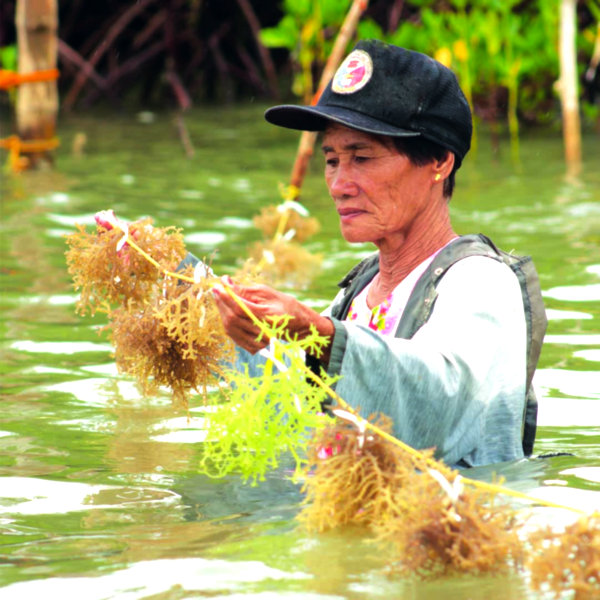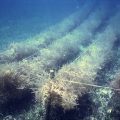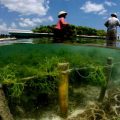With seaweeds’ wide range of uses from food and fertilizer to cosmetic and pharmaceutical industries, seaweed farming has rapidly grown into an industry that offers sustainable income and employment to fishers. The Philippines, one of the world’s biggest producers of the semi-processed seaweed product called Carageenan, cites seaweeds as its top aquaculture commodity, followed by milkfish and tilapia.
Seaweed farming has been generating livelihood for many coastal communities in the country since the 1970s. With seaweed farming not entirely limited to men, the industry has also opened livelihood opportunities for women, with some becoming economically active for only the first time.

Women Winning at Seaweeds
This has been the case for the members of the women’s organizations tapped by the Bureau of Fisheries and Aquatic Resources (BFAR)-Region V in the implementation of the project, “Product Development/Improvement and Commercialization of Seaweeds in Bicol Region”.
Funded by the Bureau of Agricultural Research (BAR) under the National Technology Commercialization Program (NTCP), the project tapped existing organizations such as the Tabaco Faith International Church (TFIC) Ladies Association, Tobaco, Albay and Rural Improvement Club of Layog, Barcelona, Sorsogon,
Through the seminars and trainings that the team of BFAR V Research Manager Aida Andayog conducted, the members of these organizations were taught how to formulate, produce, develop, package and market food products processed from seaweeds.
“We also conducted trainings and held seminars to educate farmers and the organizations’ members on the principles of good manufacturing practices (GMP) and sanitation standard operating procedures (SSOP),” says Andayog. GMP and SSOP are prerequisites of the Hazard Analysis Critical Control Points Program (HACCP), an internationally recognized guarantee of the quality of food products.
Aside from these, Andayog takes pride in the tests that the group successfully conducted to really ensure the quality of their seaweed products. “Our products underwent sensory evaluation to assess the products’ appearance, odor, flavor and textures, and, more importantly, their nutritional value through nutritional evaluation. We also conducted microbiological analysis of our products, such as seaweed juice, pickled seaweeds and nata de seaweeds, as well as nutritional analysis of various seaweed-finished food products,” Andayog adds.
According to Nimfa B. Moreno, a seaweed processor and member of the TFIC Ladies Association, not only has the project provided the seaweed processors with additional knowledge on the processing of seaweed for food, thus increasing their income opportunities, but has also taught the people in the communities to use their time well by taking part in seaweed-related ventures. She says the biggest benefit of the project was that it made the people realize that they can help themselves through entrepreneurship, and this helps make sure that the purpose of the project will continue even after the project is concluded.
Seaweed-based products expand into enterprises
Aside from the commercialization of seaweeds and processed seaweed products in Bicol, the project also aimed to establish village-level seaweed production and processing enterprises, providing greater chances for Bicolano fisherfolk and seaweed processors to engage in agribusiness. Thus, to further pursue this goal, the project, “Commercialization of Seaweed Products and Other Fishery Value-Added products in Bicol Region,” was implemented by BFAR-Region V.
The demand for seaweed-based products can be easily met by the six Bicol provinces now actively engaged in seaweed farming: Albay, Camarines Sur, Camarines Norte, Sorsogon, Catanduanes, and Masbate, with Sorsogon being the top producer due to its vast coastal waters. To encourage even more fisherfolk and coastal communities to engage in seaweed farming and product development, various techno-demo and training activities were conducted by the projects.
The uniqueness, taste, and nutritional value of Bicol-made seaweed products, which Andayog noted as their competitive advantage, play a significant role in commercializing and marketing them. According to her, “Seaweeds are nutritious. They can help build and sustain the broad nutritional requirements and balance of vitamins, minerals and vital nutrients on which optimum health and vitality depend.”
In 2012, the TFIC Ladies group produced about two tons of pancit fortified with seaweeds which were marketed and sold in Manila and Cebu, even reaching as far as South Korea. Developed and packaged seaweed products were also displayed and marketed by the organization in various trade fairs and exhibits for product promotion and market-matching.
Seaweed pancit and nata de seaweed have both give the project beneficiaries return-on-investment (ROI) of 65 percent on the average, with annual net income hitting P93,600 and P15,360, respectively. Seaweed pickles yielded a net income of P34,512 with a 70 percent ROI.
Other food products derived from seaweed also posted high ROIs: seaweed marmalade (89%), candied dried seaweed (86%), seaweed chips (79%), seaweed cracknels (67%), seaweed chocolate (85%), seaweed tart (71%), seaweed morcon (94%), seaweed longanisa (66%), fish lumpia with seaweeds (76%) and yema with seaweeds (55%).
Seaweed products continue to provide extra income, not only to the women of the TFIC, but also to other organizations that BFAR Region V has trained. And, as these and other products to be developed improve in taste and quality, it will not be long before these become national and international hits, and good sources of health and wellness, income, and pride for the Bicolanos. ### (Mara Shyn Valdeabella) –http://www.bar.gov.ph




